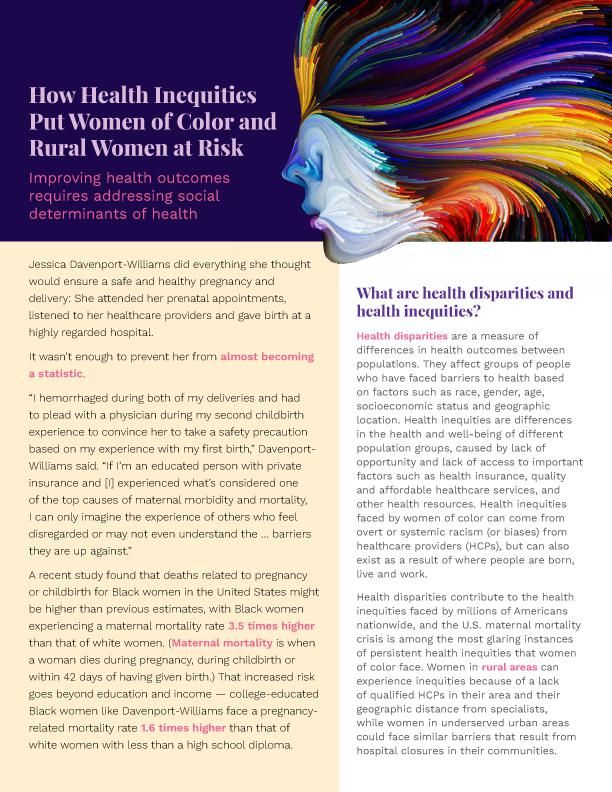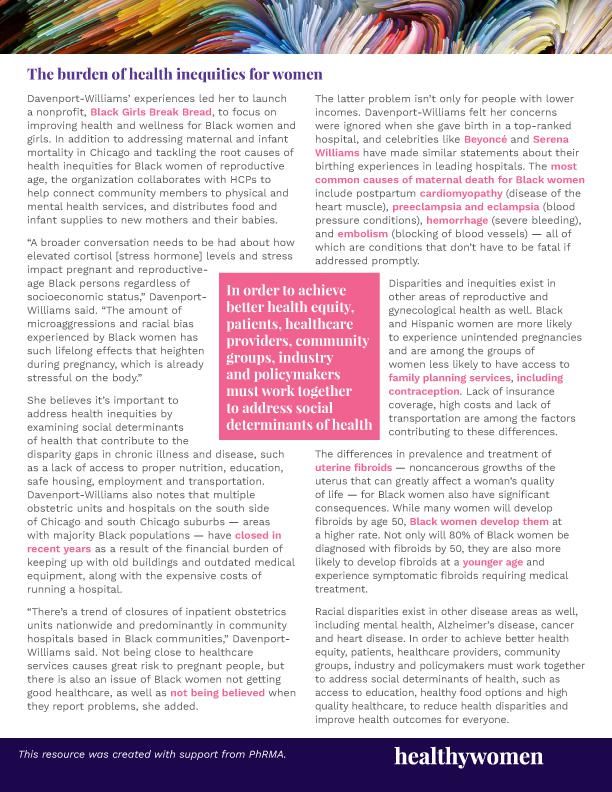Jessica Davenport-Williams did everything she thought would ensure a safe and healthy pregnancy and delivery: She attended her prenatal appointments, listened to her healthcare providers and gave birth at a highly regarded hospital.
It wasn’t enough to prevent her from almost becoming a statistic.
“I hemorrhaged during both of my deliveries and had to plead with a physician during my second childbirth experience to convince her to take a safety precaution based on my experience with my first birth,” Davenport-Williams said. “If I’m an educated person with private insurance and [I] experienced what’s considered one of the top causes of maternal morbidity and mortality, I can only imagine the experience of others who feel disregarded or may not even understand the … barriers they are up against.”
A recent study found that deaths related to pregnancy or childbirth for Black women in the United States might be higher than previous estimates, with Black women experiencing a maternal mortality rate 3.5 times higher than that of white women. (Maternal mortality is when a woman dies during pregnancy, during childbirth or within 42 days of having given birth.) That increased risk goes beyond education and income — college-educated Black women like Davenport-Williams face a pregnancy-related mortality rate 1.6 times higher than that of white women with less than a high school diploma.
What are health disparities and health inequities?
Health disparities are a measure of differences in health outcomes between populations. They affect groups of people who have faced barriers to health based on factors such as race, gender, age, socioeconomic status and geographic location. Health inequities are differences in the health and well-being of different population groups, caused by lack of opportunity and lack of access to important factors such as health insurance, quality and affordable healthcare services, and other health resources. Health inequities faced by women of color can come from overt or systemic racism (or biases) from healthcare providers (HCPs), but can also exist as a result of where people are born, live and work.
Health disparities contribute to the health inequities faced by millions of Americans nationwide, and the U.S. maternal mortality crisis is among the most glaring instances of persistent health inequities that women of color face. Women in rural areas can experience inequities because of a lack of qualified HCPs in their area and their geographic distance from specialists, while women in underserved urban areas could face similar barriers that result from hospital closures in their communities.
The burden of health inequities for women
Davenport-Williams’ experiences led her to launch a nonprofit, Black Girls Break Bread, to focus on improving health and wellness for Black women and girls. In addition to addressing maternal and infant mortality in Chicago and tackling the root causes of health inequities for Black women of reproductive age, the organization collaborates with HCPs to help connect community members to physical and mental health services, and distributes food and infant supplies to new mothers and their babies.
“A broader conversation needs to be had about how elevated cortisol [stress hormone] levels and stress impact pregnant and reproductive-age Black persons regardless of socioeconomic status,” Davenport-Williams said. “The amount of microaggressions and racial bias experienced by Black women has such lifelong effects that heighten during pregnancy, which is already stressful on the body.”
She believes it’s important to address health inequities by examining social determinants of health that contribute to the disparity gaps in chronic illness and disease, such as a lack of access to proper nutrition, education, safe housing, employment and transportation. Davenport-Williams also notes that multiple obstetric units and hospitals on the south side of Chicago and south Chicago suburbs — areas with majority Black populations — have closed in recent years as a result of the financial burden of keeping up with old buildings and outdated medical equipment, along with the expensive costs of running a hospital.
“There’s a trend of closures of inpatient obstetrics units nationwide and predominantly in community hospitals based in Black communities,” Davenport-Williams said. Not being close to healthcare services causes great risk to pregnant people, but there is also an issue of Black women not getting good healthcare, as well as not being believed when they report problems, she added.
The latter problem isn’t only for people with lower incomes. Davenport-Williams felt her concerns were ignored when she gave birth in a top-ranked hospital, and celebrities like Beyoncé and Serena Williams have made similar statements about their birthing experiences in leading hospitals. The most common causes of maternal death for Black women include postpartum cardiomyopathy (disease of the heart muscle), preeclampsia and eclampsia (blood pressure conditions), hemorrhage (severe bleeding), and embolism (blocking of blood vessels) — all of which are conditions that don’t have to be fatal if addressed promptly.
Disparities and inequities exist in other areas of reproductive and gynecological health as well. Black and Hispanic women are more likely to experience unintended pregnancies and are among the groups of women less likely to have access to family planning services, including contraception. Lack of insurance coverage, high costs and lack of transportation are among the factors contributing to these differences.
The differences in prevalence and treatment of uterine fibroids — noncancerous growths of the uterus that can greatly affect a woman’s quality of life — for Black women also have significant consequences. While many women will develop fibroids by age 50, Black women develop them at a higher rate. Not only will 80% of Black women be diagnosed with fibroids by 50, they are also more likely to develop fibroids at a younger age and experience symptomatic fibroids requiring medical treatment.
Racial disparities exist in other disease areas as well, including mental health, Alzheimer’s disease, cancer and heart disease. In order to achieve better health equity, patients, healthcare providers, community groups, industry and policymakers must work together to address social determinants of health, such as access to education, healthy food options and high quality healthcare, to reduce health disparities and improve health outcomes for everyone.
This resource was created with support from PhRMA.









